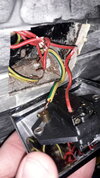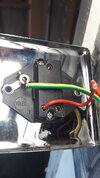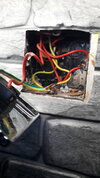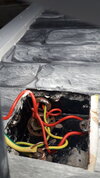So was gluing some of those stone look PVC tiles to kitchen wall today. Thought I would do things properly and unscrewed the kitchen light switch to cut the hole out neat and have a professional look to things. So the tile sheets do look great around the light socket.
However some wires came lose in the light switch, and my kitchen light and living room light (room next door) no longer work. I have tried a few things but can't either to work. Never seen a light switch wiring like this before.
The red live wire is still connected fine. I am not sure what to do with the 3 green/yellow earth wires. I *think* at least 2 of the green/yellow wires were wrapped around a screw located in middle bottom of light switch (the screw is not part of the switch panel or used otherwise). If anyone can help advise what needs to be done and what needs to go where, will be most grateful.
I attach a photo.
However some wires came lose in the light switch, and my kitchen light and living room light (room next door) no longer work. I have tried a few things but can't either to work. Never seen a light switch wiring like this before.
The red live wire is still connected fine. I am not sure what to do with the 3 green/yellow earth wires. I *think* at least 2 of the green/yellow wires were wrapped around a screw located in middle bottom of light switch (the screw is not part of the switch panel or used otherwise). If anyone can help advise what needs to be done and what needs to go where, will be most grateful.
I attach a photo.
Attachments
Last edited:





